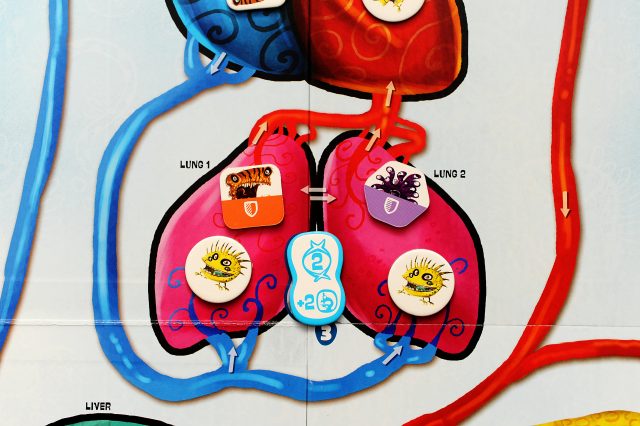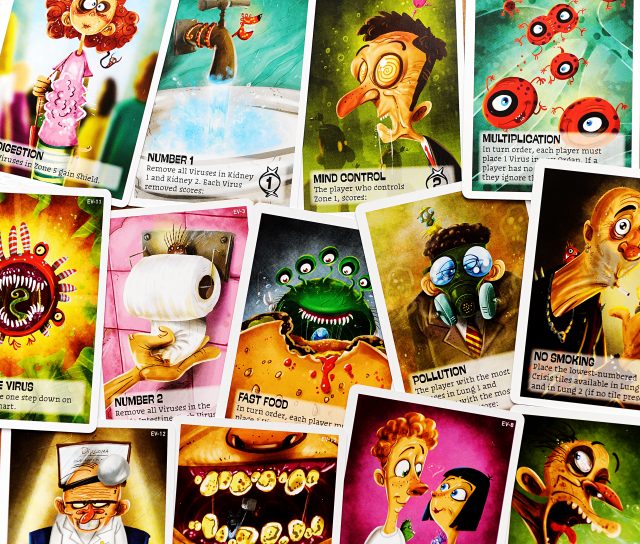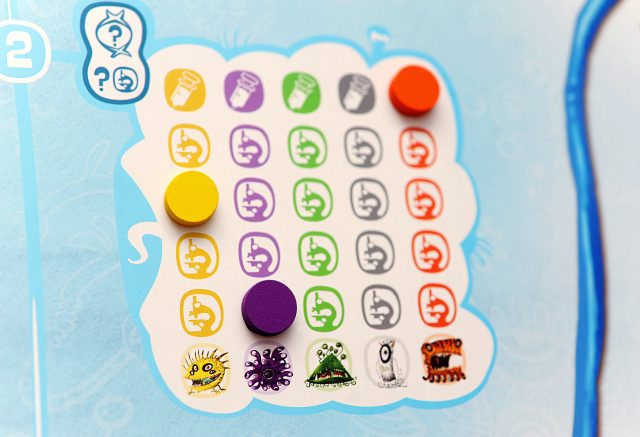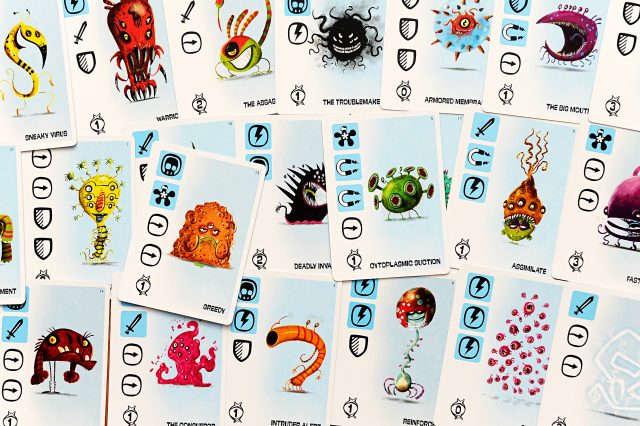It is the goal of every living thing to survive and even multiply when possible. This is true for mammals, reptiles, birds, all the way down to the tinniest microscopic organisms. Life finds a way. In Viral, players take control of one of the many viruses infected some poor sap, whose days are numbered. The key is to spread your sick around, and gain points for controlling different parts of the body.
 Viral is an action selection and area control game where the battle ground is a human body. It is divided up into different organs and the organs come together to form six different zones. Players gain points by spreading their virus around and controlling zones with a Virus tile in each organ in the zone. The trick is making sure your disease thrives, without allowing too much research to be done. That could lead to a cure being found and your disease being expunged from the body.
Viral is an action selection and area control game where the battle ground is a human body. It is divided up into different organs and the organs come together to form six different zones. Players gain points by spreading their virus around and controlling zones with a Virus tile in each organ in the zone. The trick is making sure your disease thrives, without allowing too much research to be done. That could lead to a cure being found and your disease being expunged from the body.
Viral is played over six rounds, broken up into six different phases. The first player marker rotates and players select two sets of cards from their hands. On either side of their player board they will place a Mutation card and a Zone card. Then starting with the first player, they will reveal their cards and perform their actions. Mutation cards indicate which actions a player can take (such as infected organs, moving Virus tiles around the body, attacking other Viruses, drawing Viruses towards yours, and even absorbing other Viruses), Zone cards determine where the actions have to take place if they have a blue back indicating they must adhere to a Zone.
In the second phase, doctors make a valiant attempt to find a cure for the patient. Players will go through the body, zone by zone, from the Brain all the way down to the Kidneys. You check to see if anyone controls the entire Zone by having a Virus tile in each of the organs in the Zone. If someone does, they will get points as indicated by the Zone tile. Then, they slide their research token up on the research chart the number of spaces indicated on the Zone tile.
 In the third phase, Events take place. At the start of the game six of the 13 Event cards are chosen at random and form a face up deck on the board. Players will always be able to see what Event is coming up for the round and prepare for it. Most of the Events are good things for some or all of the players. They get a chance to earn points for being in certain organs, or controlling Zones, or they get a chance to spread their disease around the body a little bit more. Viral has a great sense of humour, from its premise all the way to its execution, but in my mind, it’s never more evident than with the Event cards. The art by Milhajlo Dimitrievski is delightfully reminiscent of Jon Kricfalusi’s classic show, Ren and Stimpy. Each image looks like it could have been pulled right from the frames of one of the episodes.
In the third phase, Events take place. At the start of the game six of the 13 Event cards are chosen at random and form a face up deck on the board. Players will always be able to see what Event is coming up for the round and prepare for it. Most of the Events are good things for some or all of the players. They get a chance to earn points for being in certain organs, or controlling Zones, or they get a chance to spread their disease around the body a little bit more. Viral has a great sense of humour, from its premise all the way to its execution, but in my mind, it’s never more evident than with the Event cards. The art by Milhajlo Dimitrievski is delightfully reminiscent of Jon Kricfalusi’s classic show, Ren and Stimpy. Each image looks like it could have been pulled right from the frames of one of the episodes.
Now the human body is a wonderful thing, and even without medical intervention it will attempt to fight of the Viruses making their way throughout the internal organs. In phase four, the immune response kicks in. Organs go into crisis for a number of different reasons. When they do, the lowest Crisis token available is placed on that organ. During the Immune Response, the  Crisis tokens are resolved in order. The player with the most Virus tiles in the organ will receive two points and everyone else with a Virus tile present will get one point. After scoring, all of the Virus tiles are removed from the board. The body has won that round and fought off the infection.
Crisis tokens are resolved in order. The player with the most Virus tiles in the organ will receive two points and everyone else with a Virus tile present will get one point. After scoring, all of the Virus tiles are removed from the board. The body has won that round and fought off the infection.
Doctors are always looking for cures and if a disease gets bad enough, they’ll throw all of their research behind it. For any player whose Research token has reached the top of the Research chart, a cure has been found, and all of their Virus tiles in the patient are removed.
Finally, in phase six the round ends. Any Virus tiles that were absorbed are released and the tie-break track is rearranged, so the players with the lowest score are at the top of the track. You’re ready for the next round.
 As you advance along the scoring track, you’re able to acquire more powerful Mutation cards. There are always three face-up to choose from, or you can draw from the top of the deck. These new Mutations are also worth end game points. Typically, the more powerful the card you choose, the less points it will be worth, so you have to balance your decision.
As you advance along the scoring track, you’re able to acquire more powerful Mutation cards. There are always three face-up to choose from, or you can draw from the top of the deck. These new Mutations are also worth end game points. Typically, the more powerful the card you choose, the less points it will be worth, so you have to balance your decision.
Viral is a very interesting game with a lot to consider each round. Ultimately, you want to put yourself in a position to control the Zones worth the most points, but of course, so does everyone else. You might be ready to pick up some points from the Kidneys, when some other Virus comes along and absorbs you, and maybe even moves you to another organ. Speaking of movement, it happens in a really cool way. You need to  follow the flow of the various systems and organs. Just being adjacent to an organ doesn’t mean you can move there. Veins, arteries, and various other tubing, that a doctor would be better at explaining, carry the Viruses through the body to their next target. You have to keep in mind the flow of the body and whether you can move where you want, before you plan your attack. Taking actions with the Shield icon, will allow you flip one of your Virus tile to the protected side. Now when they would normally be removed from the board, they are simply flipped back over.
follow the flow of the various systems and organs. Just being adjacent to an organ doesn’t mean you can move there. Veins, arteries, and various other tubing, that a doctor would be better at explaining, carry the Viruses through the body to their next target. You have to keep in mind the flow of the body and whether you can move where you want, before you plan your attack. Taking actions with the Shield icon, will allow you flip one of your Virus tile to the protected side. Now when they would normally be removed from the board, they are simply flipped back over.
After six rounds of actions, players add any points they have on Mutation cards and a dominant disease is declared.
I’m finding with games these days an influx of creativity in both the design and the theme. The idea of an area control game that takes place entirely within a human body is just brilliant. It’s a bit morbid when you stop to consider what you’re actually doing with your actions, but the execution is so light hearted it’s hard to take the game seriously. The art, mechanics, and simple components come together to form an excellent package. I think Viral has done something interesting with some tried and tested mechanics and that can be a challenge. Definitely check it if you’re looking for a unique game with a classic feel to it.
[…] Download Image More @ dailyworkerplacement.com […]